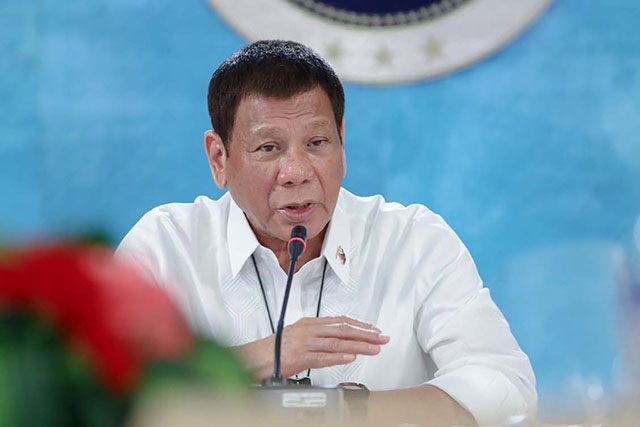
President Rodrigo Duterte defended his absence anew amid the onslaught of Super Typhoon Rolly in his recorded weekly address aired Thursday night.
The chief executive reiterated that he was in his hometown, Davao City, when this year’s strongest tropical cyclone battered parts of Luzon and Visayas as the country entered the penultimate month of the year.
“Uulitin ko lang sa mga tao, hindi nila alam ay umuwi ako ng probinsiya sa Davao kasi Araw ng Patay. Iyon ‘yung araw na kasagsagan nang dumaan ang bagyo,” Duterte said in his speech.
He visited his parents’ grave in Davao on October 28, prior to the government’s mandated cemetery closure to prevent mass gatherings amid the coronavirus pandemic.
“Rolly” entered the Philippine Area of Responsibility on October 29 and made its first landfall in Bato, Catanduanes on the early morning of November 1.
Cabinet secretaries and disaster management officials addressed the nation at 10 a.m. on the same day. By that time, the tropical cyclone already made its second landfall on Tiwi, Albay at 7:20 a.m.
Duterte’s absence on the first high-level briefing of the tropical cyclone has prompted Filipinos to ask about his whereabouts as news updates about the typhoon and its potential impacts continuously filled their social media feeds.
In the past, he has been able to conduct meetings with other high-level officials about the coronavirus despite being in his hometown through video conferencing.
RELATED: Throwback to Duterte’s ‘Yolanda’ efforts amid absence during ‘Rolly’
Presidential spokesperson Harry Roque said that the chief executive was “closely monitoring” the situation at that time and was unable to go back to Manila because of extreme weather conditions.

Duterte in his speech once again accused his critics of supposedly wanting him to “greet” the tropical cyclone head-on and “commit suicide” despite the public only asking for his presence in the high-level briefing and not within the super typhoon’s periphery.
“But the following day, kinabukasan, mga alas-tres, nag-touchdown na ako sa NAIA. Tuloy na ako from the NAIA airport, diretso na ako sa Bicol. Guinobatan, nag-landing ako doon, kinausap ko ‘yung mga tao. But I also had an accurate view of the destruction brought about by the typhoon,” he added as he explained his absence.
“Umuwi ako kasi may… patay na ang nanay ko pati tatay ko,” Duterte further said.
The president conducted an aerial survey of Albay and Catanduanes, the provinces that were hit by the hardest by the super typhoon, on Monday.
He also visited the town of Guinobatan in Albay to see the severity of the damage inflicted by the tropical cyclone.
Importance of public presence
Meanwhile, some Filipinos were not amused with his explanations as they corrected his claims about his absence during the “Rolly” briefing.
“To me, he has forgotten the tenets of proactive leadership. The people asked him not to Manila Bay and to do suicide. What the people were asking him is to do (is) just that proactive leadership then in anticipation of Typhoon Rolly by convening the NDRRMC via Zoom or Cisco,” a Twitter user said.
“No, the people just wanted to be assured that you were on top of things. A simple 5-10 minute address would have sufficed, if it contained a firm promise and a concise plan of action,” another online user wrote in response to Duterte’s remarks.
“Ganda sana kung isang link lang (your address) ang i-share, e mas maliwanagan at mabuhayan na ang mga taong expected na masalanta ng bagyo,” the user added.
“But the thing is, (it is) an emergency situation BUT the head of the state is MIA (missing-in-action). ‘Yun ‘yung issue dito,” another Filipino wrote with an angry emoji.
“Point is, you were missing. That’s it. Being president doesn’t give you a leeway nor excuse to abandon your post. Let’s get real. Alam mo nga na kasagsagan ng bagyo eh. Resign,” a Twitter user said.
Super Typhoon Rolly last weekend slammed parts of Southern Luzon and Visayas and displaced lots of families in Catanduanes and Albay amid an ongoing pandemic.
The tropical cyclone also affected people from Regions 2, 3, CALABARZON, MIMAROPA, Region V and the National Capital Region.
It was also the first time for a while that Metro Manila was placed under Tropical Cyclone Wind Signals No. 3 and 4, both considered destructive, by the state weather bureau.
As of Friday morning, there are 22 people who have lost their lives due to the super typhoon. The tally was previously 24 but one individual was struck off the list since his death was not attributed to “Rolly.” Another death was still being verified by the authorities.
A political scientist noted that leaders should be able to appreciate how important their messages are especially in times of crisis.
“I think that leaders sometimes underestimate the effect of their own words, especially the [effects of] things they don’t say as well as the things they do say,” Arjen Boin said in an interview.
Ira Helsloot of the Crisislab at Radboud University in The Netherlands said that the content of political messages can be more crucial than the actual decision-making, as far as public approval and trust go.
“People want the leader to project compassion and an understanding of how the situation is for those concerned, and to project the hope that together we can manage the crisis, even though we don’t know everything about the present situation,” he said.









